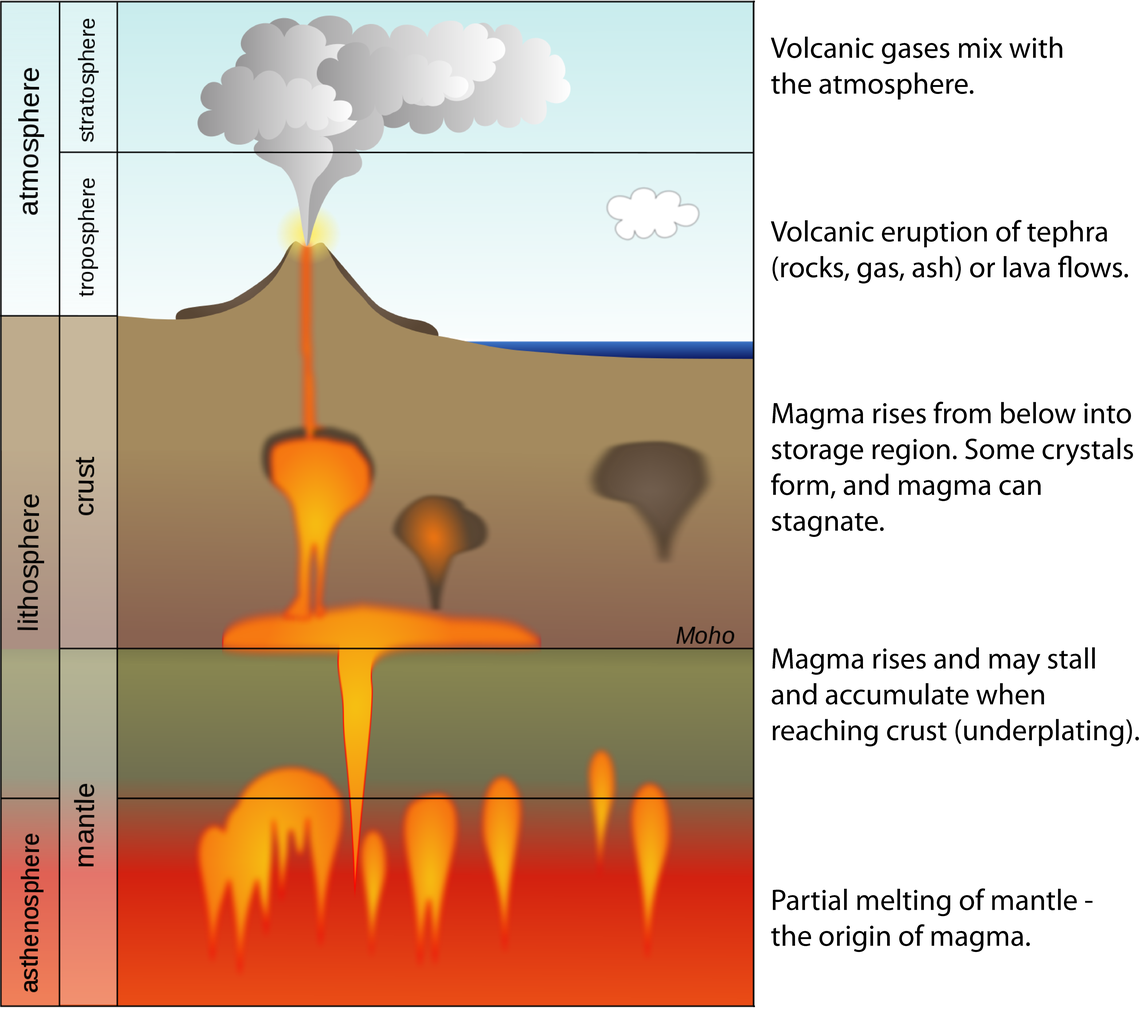Yellowstone's Magma Reservoir: Implications For Future Eruptions

Table of Contents
The Size and Composition of Yellowstone's Magma Reservoir
Understanding the Reservoir's Dimensions
The Yellowstone magma reservoir is a complex system, not a single, easily defined chamber. Scientific understanding of its dimensions is constantly evolving thanks to advanced geophysical techniques. Researchers utilize various methods to map its extent and characteristics:
- Seismic tomography: By analyzing seismic waves generated by earthquakes, scientists create 3D images of the subsurface, revealing the location and extent of molten rock.
- GPS measurements: Precise GPS stations track subtle ground deformation, indicating changes in magma pressure beneath the surface.
- Gravity surveys: Variations in Earth's gravitational pull can reveal density differences, helping to identify the location of dense magma bodies.
Current estimates suggest the reservoir extends over a vast area, reaching depths of several kilometers and encompassing a volume of hundreds of cubic kilometers. While the exact dimensions remain uncertain, the sheer scale underscores the potential power of the Yellowstone supervolcano.
Magma Composition and Viscosity
The magma within Yellowstone's reservoir is primarily rhyolitic, meaning it is rich in silica. This high silica content makes the magma highly viscous, or thick, which significantly influences its eruptive behavior. Key compositional characteristics include:
- High silica content: This leads to a higher tendency for explosive eruptions, as dissolved gases cannot easily escape the viscous magma.
- Significant gas content: The presence of dissolved gases like water vapor and carbon dioxide further contributes to the explosive potential.
- Relatively high temperature: Although not as hot as some basaltic magmas, the temperature of the Yellowstone magma is still high enough to maintain a molten state.
The combination of high viscosity and high gas content increases the likelihood of future explosive eruptions, similar to those that have shaped Yellowstone's landscape throughout its history.
Past Eruptive History and Recurrence Intervals
Major Eruptions Throughout History
Yellowstone's geological history is marked by three cataclysmic supereruptions, each leaving an indelible mark on the surrounding landscape:
- Huckleberry Ridge Tuff (2.1 million years ago): This eruption ejected an estimated 2,500 cubic kilometers of material, creating the Island Park Caldera.
- Mesa Falls Tuff (1.3 million years ago): This eruption produced roughly 300 cubic kilometers of ejected material, forming a significant portion of the Yellowstone Plateau.
- Lava Creek Tuff (640,000 years ago): This eruption, responsible for the present-day Yellowstone Caldera, expelled approximately 1,000 cubic kilometers of material, causing widespread ashfall across North America.
The immense scale of these eruptions highlights the potential for future devastating events.
Predicting Future Eruptive Activity
Predicting future eruptions at Yellowstone is a complex challenge. While it is unlikely another supereruption will occur in the near future, smaller, less catastrophic events are possible. Scientists employ various strategies:
- Statistical models: By analyzing the timing and magnitude of past eruptions, statistical models help to assess the probability of future events. However, such models are inherently limited by the relatively short observational record of human history compared to the geological timescale.
- Geophysical monitoring: Continuous monitoring of seismic activity, ground deformation, gas emissions, and geothermal features provides crucial data to track changes in the reservoir's state. This involves a network of highly sensitive instruments strategically placed throughout the region.
The complexity of the magma system and the limitations of current predictive models mean that any forecast of future eruptions remains probabilistic, not deterministic.
Monitoring Techniques and Early Warning Signs
Advanced Monitoring Systems
The Yellowstone Volcano Observatory (YVO) employs a sophisticated network of monitoring tools to track the magma reservoir's activity:
- Seismic monitoring networks: A dense array of seismometers constantly records earthquake activity, providing insights into magma movement and pressure changes.
- GPS measurements: High-precision GPS stations precisely measure ground deformation, providing early warnings of potential inflation or deflation of the magma chamber.
- Gas geochemistry: Monitoring gas emissions (CO2, SO2, etc.) from fumaroles and geysers can reveal changes in the magma's composition and pressure. These gases can offer valuable clues to the conditions below the surface.
These data streams are continuously analyzed to detect any unusual patterns that might indicate an impending eruption.
Recognizing Precursory Signals
While there are no foolproof predictors, scientists look for several potential precursory signals that might precede a volcanic eruption:
- Increased seismic activity: A significant increase in the frequency and intensity of earthquakes could indicate magma movement.
- Ground deformation: Uplift or subsidence of the ground surface can reflect changes in magma pressure beneath.
- Altered gas emissions: Changes in the composition and flux of volcanic gases can indicate changes in the magma system.
- Changes in geothermal features: Alterations in geyser activity or hot spring temperatures could signal shifts in subsurface heat flow.
Interpreting these signals remains challenging, as natural variations can sometimes mimic precursory signs. However, by carefully monitoring multiple parameters, scientists can significantly improve their ability to detect potential precursors and assess the level of volcanic unrest.
Conclusion
Yellowstone's magma reservoir represents a potent geological force capable of producing significant eruptions. Understanding its size, composition, eruptive history, and current activity through sophisticated monitoring techniques is crucial for assessing potential hazards and mitigating future risks. While predicting the precise timing and magnitude of future eruptions remains a significant scientific challenge, continued research and advanced monitoring efforts are vital for enhancing our preparedness for such events. Understanding Yellowstone's magma reservoir is crucial for the safety and well-being of surrounding communities. Stay informed about the latest research and monitoring efforts related to Yellowstone's magma reservoir and the broader subject of Yellowstone supervolcano activity to better appreciate this powerful geological force.

Featured Posts
-
 Where To Stream The 1923 Season 2 Finale Episode 7 Release Time And Details
May 27, 2025
Where To Stream The 1923 Season 2 Finale Episode 7 Release Time And Details
May 27, 2025 -
 Analiz Isw Pozitsiya Putina Schodo Kompromisiv U Peregovorakh Z Ukrayinoyu
May 27, 2025
Analiz Isw Pozitsiya Putina Schodo Kompromisiv U Peregovorakh Z Ukrayinoyu
May 27, 2025 -
 Was Geschah Am 9 Mai Historische Ereignisse Und Wichtige Daten
May 27, 2025
Was Geschah Am 9 Mai Historische Ereignisse Und Wichtige Daten
May 27, 2025 -
 The Victor Osimhen To Chelsea Transfer Saga Continues
May 27, 2025
The Victor Osimhen To Chelsea Transfer Saga Continues
May 27, 2025 -
 Real Memorial Day Deals Worth Checking Out
May 27, 2025
Real Memorial Day Deals Worth Checking Out
May 27, 2025
Latest Posts
-
 Journalists Under Threat Reporting On Bolle Joss Drug Trafficking In Sierra Leone
May 30, 2025
Journalists Under Threat Reporting On Bolle Joss Drug Trafficking In Sierra Leone
May 30, 2025 -
 Analysis The Dismissal Of Sierra Leones Immigration Chief
May 30, 2025
Analysis The Dismissal Of Sierra Leones Immigration Chief
May 30, 2025 -
 Live Streaming Pasxa E Thessalia Gr
May 30, 2025
Live Streaming Pasxa E Thessalia Gr
May 30, 2025 -
 The Suppression Of Press Freedom In Sierra Leone The Bolle Jos Case
May 30, 2025
The Suppression Of Press Freedom In Sierra Leone The Bolle Jos Case
May 30, 2025 -
 Leijdekkers Links To Sierra Leones First Family May Prevent Extradition
May 30, 2025
Leijdekkers Links To Sierra Leones First Family May Prevent Extradition
May 30, 2025
